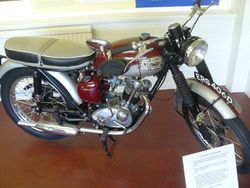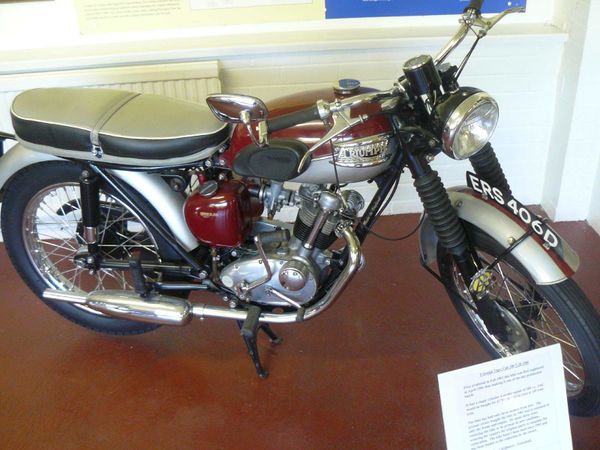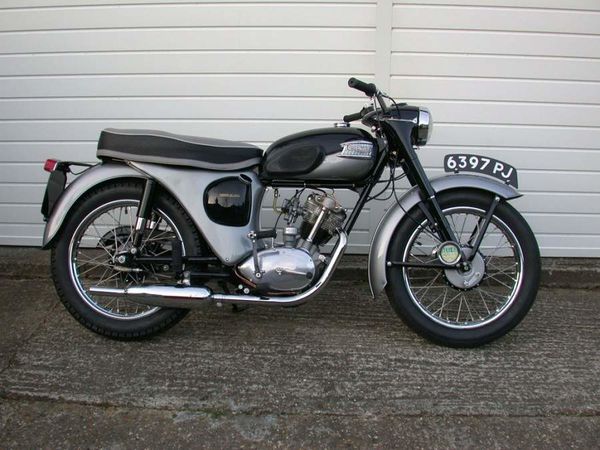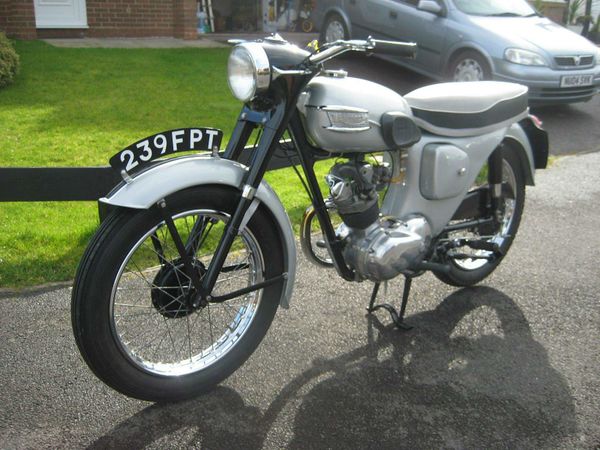Triumph Tiger Club 200
 |
|
| Triumph Tiger Club 200 | |
| Manufacturer | |
|---|---|
| Production | 1956 - 68 |
| Engine | Four stroke, single cylinder, OHV |
| Compression ratio | 7:1 |
| Top Speed | 97 km/h / 60 mph |
| Transmission | 4-Speed |
| Frame | Single tubular steel cradle |
| Suspension | Front: Telescopic fork, hydraulically dampened Rear: Swingarm, twin shocks, hydraulically dampened |
| Brakes | Front: 5.5 in Drum Rear: 5.5 in Drum |
| Wheelbase | 1245 mm / 49 in |
| Weight | 95 kg / 210 lbs (dry), 113 kg / 250 lbs (wet) |
| Fuel Capacity | 13.6 L / 3.6 US gal / 3.0 Imp gal |
| Manuals | Service Manual |
It could reach a top speed of 97 km/h / 60 mph.
Engine[edit | edit source]
The engine was a Air cooled cooled Four stroke, single cylinder, OHV. The engine featured a 7:1 compression ratio.
Drive[edit | edit source]
Power was moderated via the Wet, multi-plate.
Chassis[edit | edit source]
Stopping was achieved via 5.5 in Drum in the front and a 5.5 in Drum in the rear. The front suspension was a Telescopic fork, hydraulically dampened while the rear was equipped with a Swingarm, twin shocks, hydraulically dampened. The Tiger Club 200 was fitted with a 13.6 L / 3.6 US gal / 3.0 Imp gal fuel tank. The bike weighed just 95 kg / 210 lbs. The wheelbase was 1245 mm / 49 in long.
Photos[edit | edit source]
Overview[edit | edit source]
Triumph Tiger Cub 200
The little tiger started life as a 150cc. Created to match the BSAs of the time i.e. the Bantam 125 and the C15 250. Triumph tried to tap from both these models and created something in between. TheTriumph Tiger Cub was first shown to the public at the Earls Courtshow in 1953. The cub or T20 was an extended model from the earlier Triumph Terrier. There is also an off road version of the cub designated the T20C. The cub was a popular learner motorcycles as any 16 year old can put both their feet on the ground while on the bike. The bike was really low so much so it made its bigger brother the T21 feel much much bigger. Triumph's Tiger Cub was designed unashamedly to appeal to admirers of the company's sporting twins With the hand of master stylist Edward Turner in evidence, they were an attractive alternative to a string of lightweights powered by Villiers two-strokes. The 'Baby Bonnies' provided a desirable apprenticeship on two wheels for a generation of youths, and a ride-to-work bike with style. After 1960, when learners were restricted to bikes of less than 250cc, the Cub's appeal was enormously enhanced. Although by the 1950s Triumph was very much associated with twins, thanks to its trend-setting Speed Twin and later derivatives, pre-war much of its production had centred on sports singles. The first post-war single was the much more mundane Terrier - a 1500cc machine very much aimed at the commuter market, which Triumph had tended to forsake in recent years. Looking much like the Cub that followed, the Terrier was designed as a baby version of the twins, and was distinguished from many of its cheaper competitors by an air of completeness and quality. Its weakest points were rear suspension by plungers, and a big end assembly that proved rather too short-lived. The engine was built in unit with a four-speed gearbox and enclosed in a streamlined casing. The first Cub, the T20, was simply a larger version of the Terrier, using the same plunger frame and cycle parts. A weak area of the frame that persisted for years was the swan-necked and unsupported headstock. This was braced by the tank, which was constructed in such a way that if this was replaced with another type of tank, the frame could prove extremely flimsy. Apart from an increase in bore and stroke to give a capacity of I99cc, the engine unit changed little from original Terrier including its irritating drawbacks. It was particularly difficult to change the chain, and a new sprocket meant major dismantling, while the alternator caused electrical problems. The clutch and big end also had to be redesigned. The Cub's bottom end was changed in 1956 to a plain bearing, but this also proved troublesome, especially in the hands of novice riders who would rev the engine before it had warmed up properly. Big end life in such circumstances was depressingly short, and Triumph suffered many warranty claims before this fundamental flaw was sorted out. A competition (off-road) version called the T20C appeared in 1957, sporting a high-level exhaust and modified wheels and suspension. The basic styling remained that of the larger Triumphs. There were numerous mechanical and styling changes over the years. Variations on a theme included sports and off-road versions, while in 1966 the Bantam Cub appeared - a hybrid with the baby Triumph engine in a BSA Bantam frame. The last Tiger Cub was the Super Cub, launched in 1967 and dropped a year later. But the Cubs had laid the seeds for its replacement by becoming the inspiration for the 250cc BSA CI5, which appeared a decade later.
Article:
Derived from the 150cc Terrier of 1952, the Cubs engine was a 199cc (63mm x 64mm bore and stroke) air-cooled, dry sump, OHV 4-stroke single with an iron cylinder and alloy head. The built-up crankshaft spun on a drive-side ball bearing with a plain bush on the timing side, and started out with a roller bearing connecting rod big end (changed to a plain bearing around 1956). Primary drive to the wet multi-plate clutch was by chain, while the 4-speed countershaft gearbox was housed in a separate chamber cast in-unit with the engine. An alternator powered the 6-volt electrical system, with the ignition points mounted in a housing on top of the timing cover. The engine breathed through an Amal Monobloc carburetor (though a Zenith instrument was also used during the late 1950s). Introduced with plunger suspension, the Cub acquired a modern swingarm frame in 1957.
The Cubs trump card was its styling. Later nicknamed the Baby Bonnie, it was designed to emulate its bigger brothers, the Triumph Speed Twin and Triumph Thunderbird, with a similar headlamp nacelle (featuring a nifty mechanical gear position indicator) and similar paint schemes. At half the price of a T-bird, the Triumph Tiger Cub allowed entry to the Triumph range for a basement price. And above all, it looked and felt like a proper motorcycle, with a solid 4-stroke thump from the exhaust and lively performance for the time; with a top speed faster than 60mph, it was definitely a cut above all the wheezing Villiers-powered 2-stroke British bikes of the day.
Though cute, the Cub had its scary side. The plain bearing big ends were prone to failure if the engine was revved hard before the oil was warm. A better oil pump was fitted from 1961, and the Cub received a complete new bottom end in 1962, which fixed the problem. Also, the primary chain had no adjuster, and sometimes broke if the case ran dry of oil, and the marginal frame used the gas tank as a stressed member if a different tank was fitted, the frame could break. Adjusting the ignition points on early models required some dexterity until the ignition plate was moved to the end of the camshaft in 1963.
Along with the stronger engine came a Triumph Sports Cub with 14.5 horsepower up 4.5 horsepower giving close to 70mph, while another variant, the TR20 Trials Cub featured a wide-ratio gearbox and a high-level exhaust. It was the Trials Cub that inspired West Coast distributor Johnson Motors sales manager Don Brown to propose to Triumph that they build a bike for the California market to compete with the small dirt bikes flooding in from Japan. Brown wanted the Trials Cubs wide-ratio box and running gear with the Sports Cubs more powerful engine. The result was the 1964 T20M Mountain Cub with Dunlop Trials tires, aluminum fenders and 7.5 inches of ground clearance. JoMo sold every one they could get, even offering a version with half tracks for winter use in the California mountains.
| Make Model | Triumph Tiger Cub 200 |
|---|---|
| Year | 1956 - 68 |
| Engine Type | Four stroke, single cylinder, OHV |
| Displacement | 199 cc / 12.1 cu in |
| Bore X Stroke | 63 x 64 mm |
| Compression | 7:1 |
| Cooling System | Air cooled |
| Lubrication System | Dry sump |
| Exhaust | One-into-one, chrome |
| Induction | Amal carburetor |
| Starting | Kick |
| Max Power | 10.4 kW / 14 hp @ 6500 rpm |
| Frame | Single tubular steel cradle |
| Clutch | Wet, multi-plate |
| Transmission | 4-Speed |
| Final Drive | Chain |
| Front Suspension | Telescopic fork, hydraulically dampened |
| Rear Suspension | Swingarm, twin shocks, hydraulically dampened |
| Front Brakes | 5.5 in Drum |
| Rear Brakes | 5.5 in Drum |
| Front Wheel | 3.00 x 17 |
| Rear Wheel | 3.00 x 17 |
| Wheelbase | 1245 mm / 49 in |
| Dry Weight | 95 kg / 210 lbs |
| Wet Weight | 113 kg / 250 lbs |
| Fuel Capacity | 13.6 L / 3.6 US gal / 3.0 Imp gal |
| Top Speed | 97 km/h / 60 mph |


